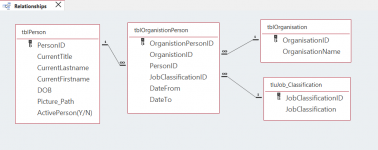mike60smart
Registered User.
- Local time
- Today, 14:48
- Joined
- Aug 6, 2017
- Messages
- 2,276
I cannot understand why you don't just use the standard Main Form / Subform as follows to
control which Persons belong to which Organisation:-
Main Form based on tblPerson and then a
Subform based on tblOrganisationPerson
with a Lookup to select Organisation and
a Lookup to selectJobClassification
control which Persons belong to which Organisation:-
Main Form based on tblPerson and then a
Subform based on tblOrganisationPerson
with a Lookup to select Organisation and
a Lookup to selectJobClassification

